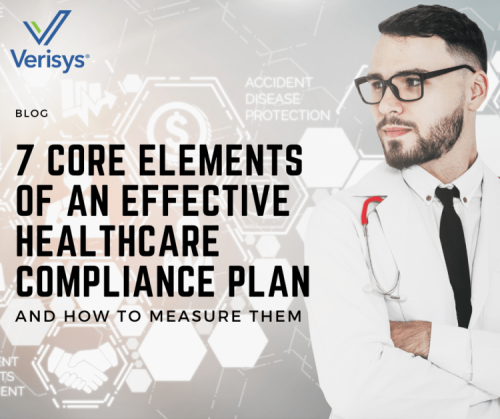– The best resource for monthly healthcare regulatory compliance updates. Compliance Updates: April 2024 Overlook: Licensure Compacts Other Legislation Board Updates Interstate Medical...


Healthcare compliance regulations are complex and ever-changing, but are an essential part of any healthcare organization’s effort to provide safe, high-quality care for patients.
Healthcare entities, especially those that receive funding from Medicaid or Medicare, must meet compliance standards set forth by the Office of Inspector General (OIG). These standards help mitigate an organization’s risk by preventing waste, fraud, and abuse.
An organization’s compliance program ensures that they meet all professional, legal, and ethical standards. So ask yourself, how effective is your organization at meeting these standards, and how do you measure your compliance program’s effectiveness?
Below we will examine seven elements of an effective compliance plan and ways that you can measure your program’s effectiveness. Keep in mind that this is not a detailed checklist on how to meet OIG requirements, but suggestions on how healthcare entities can measure compliance using available resources.
For guidance on your specific healthcare industry segment, see OIG’s compliance program guidance documents.
According to government authorities, including the Department of Justice (DOJ), an effective healthcare compliance program achieves the outcomes outlined in their compliance plan.
The DOJ goes one step further and outlines three questions you should consider when developing or measuring the effectiveness of a compliance program in their recent version (2023) of their Evaluation of Corporate Compliance Programs:
Keep these questions in mind as we look at the core elements of any healthcare compliance plan.
These 7 key elements for an effective healthcare compliance program can help you design and implement your compliance program.
1. Implement written policies and procedures regarding your healthcare organization’s commitment to state and federal standards.
Measuring effectiveness: Who has access to standards, policies, and procedures? Can employees easily locate them? Is your information ADA-compliant? Do your policies and procedures meet industry standards? How are changes to policies and procedures communicated? Does the code of conduct match your organization’s mission and values? Do employees understand the policies, and how is that assessed?
2. Designate an employee as the compliance officer and form a compliance committee.
Measuring effectiveness: Who is your designated compliance officer? To whom does the compliance officer report to? Do they feel supported by senior leadership? What resources are available to them, and are those resources adequate?
3. Conduct and ensure adequate training and education for all employees.
Measuring effectiveness: Do job descriptions clearly state an employee’s responsibility concerning compliance standards of the organization? How does the organization determine the effectiveness of training? Are learning assessments appropriate? Do you offer a variety of training materials (i.e., hands-on, video, interactive), and are they suitable for the size of your organization?
4. Develop effective lines of communication between the compliance officer and employees.
Measuring effectiveness: How does senior leadership or the compliance officer inform employees of their position related to misconduct? How do employees report events to the compliance officer in an anonymous manner? In what ways does the compliance officer communicate real-life examples of failure to comply with policies and procedures to employees?
5. Implement processes for performing internal monitoring and auditing.
Measuring effectiveness: How and what types of internal audits are carried out? How often are high-risk areas audited? How does your organization use the information obtained from internal audits? Are audit findings reported to senior leadership and the board routinely? Does senior leadership or the board follow up on audit results? Do you use a third-party auditor to help validate your results?
6. Enforce the organization’s standards through publicized disciplinary guidelines.
Measuring effectiveness: How are employees informed of the compliance program? Do policies and standards clearly define disciplinary action? Are training and documentation requirements for vendors and employees completed? How do you ensure disciplinary policies for non-compliance are applied fairly and consistently?
7. Respond to reported offenses promptly and undertake corrective action.
Measuring effectiveness: Do policies and procedures outline how and when investigations will occur? What is the process for determining which reported events are further investigated? Is there a timeline for ensuring responsiveness? How do you decide who is conducting the investigation? Does your corrective action plan(s) include all the regarded elements? Are investigators properly trained and certified? Do you conduct mock investigations to evaluate investigators’ timeliness, efficacy, professionalism, and discretion?
Compliance programs are all different, as each organization has various resources available. Regardless of the size of your organization, outsourcing elements of your compliance plan can help enhance your program and help you meet and stay compliant with OIG standards.
Verisys’ FACIS® is the gold standard healthcare dataset for screening allied health and medical professionals for exclusions, sanctions, debarments, and disciplinary actions. Our dataset mitigates risk to your organization by flagging healthcare providers who may increase risk to your organization if hired.
When it comes to credentialing healthcare providers, Verisys stays up to date on changes to state and federal laws, so you don’t have to. In addition, real-time access to the most comprehensive dataset for screening and monitoring providers allows your organization to operate with complete transparency, enhancing your compliance program.
Let Verisys help you stay compliant with government and regulatory standards. Set up an appointment today.